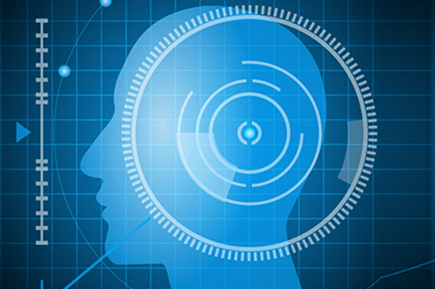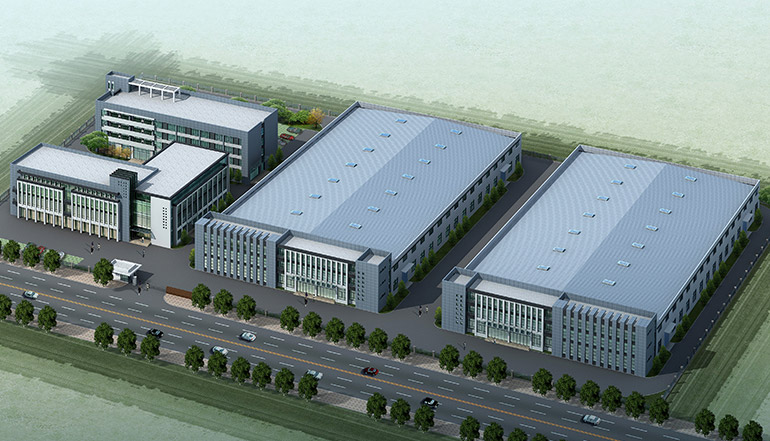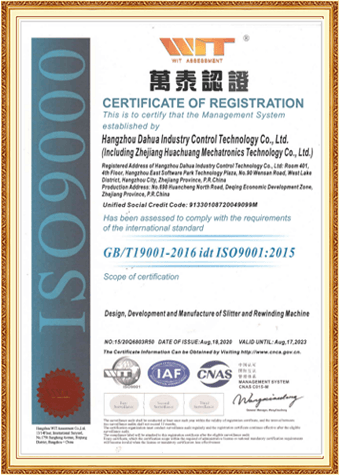
| Slitting Material | Film material such as flexible packaging film, BOPET, BOPP, BOPA, CPP,BOPI,PE,battery separating film, special paper, etc (Depend on request) |
| Material Thickness | 12um upwards (Depend on material) |
| Winding Width | 1200mm-7500mm (Depends on request) |
| Winding Diameter | 300mm-1500mm (Depend in request) |
| Winding Mode | Center Winding (Gap mode / Contact mode) |
| Winding Station | Dual Shaft |
| Slitting System | Edge cutting or without edge cutting (razor/shear) |
| Web Cutting | Flying knfie/ Direct cut (static tip can be added) |
| Osciallation | Can be optional |
| Machine Speed m/min | 10-500 m/min |
| Control System | SIEMENS Servo(Germany) |
| Roller Surface | Cork tape/rubber/metal/carbon fiber |
| Remote Control Service | Include |


Based on the knowledge of processing material and machine mechanical electrical technology, Dahua concludes the machine design from traditional 1.0 to update 2,0 and 3,0 slitter, aiming to provide cost effective products with excellent advanced performance. The 4.0 machine is also ongoing and we believe it will bring brand new feeling. With the benefit of world sourcing and purchasing for machine components, Dahua sincerely hope to make your business competitive and could get back the investment shortly.

In order to provide professional solutions with quick production, the digital management system which integrates the ERP and MES function, working as the KBMS(knowledge base management system), not only deliver accurate proposals but also make the production on time.

The intelligent slitter consists of three experts to achieve one key solution. The processing expert grows from slitting and rewinding experience with different kind of materials. Transfer the 20+ years’ big data information into smart production. The operation expert knows what customer want, automatic function make the operation more easy and friendly. The maintenance expert is standby for 24 hours, remote control service eliminate the inconvenience of travelling especially at the epidemic time.

Intelligent slitting , reduce the dependence on users

Established in December of 1999, Hangzhou Dahua Industry Control Technology Co., Ltd. is a shareholder and national high-technology/software enterprise with multi-investment. Our focus is to specialize in high value-added R&D, sales, assembly, commission and service for slitting and rewinding industry.
As a leader of slitting and rewinding technology, we find a perfect solution for our everchanging customer requirements, and integrate this into our products design and manufacture, clarified the standard and positioning of slitter, and established version 1.0, version 2.0, version 3.0 and the concept of version 4.0, respectively. With the application of intelligent technologies, our products have been achieved high efficiency and high quality production with minimum dependence on operators. Currently our products have been very popular among the customers because of reliable R&D technologies, complete product series, superior quality and reasonable price, the products are exported to Germany, the United States, Japan and other developed countries, has become the preferred brand of the majority of customers.
After more than 20 years of precipitation and accumulation, our independently developed products and technologies have obtained 32 software copyrights, 42 utility model patents, 10 invention patents and 3 appearance patents
 CE certification
CE certification
 ISO9001 certification
ISO9001 certification
 Alibaba certification
Alibaba certification
Provide you with the latest enterprise and industry news
A secondary slitter accommodates variations in material thickness and hardness through a combination of design features and adjustments. Here’s how it typically handles these variations: Adjustable Sl...
READ MOREMaintaining constant tension on the material during the slitting and rewinding process is crucial for producing high-quality rolls and avoiding issues such as wrinkling, stretching, or tearing of the ...
READ MOREPlastic film slitters use advanced blade technology to handle surface-treated or coated films without damaging the delicate coatings. Blades with special coatings, such as tungsten carbide or diamond,...
READ MOREPlastic film slitters are designed to handle a wide range of film thicknesses and types, ensuring precise and efficient slitting for various applications. Here’s how they accommodate different thickne...
READ MOREAchieving a smooth, burr-free edge on paper after slitting is critical for both the quality of the final product and for ensuring a safe handling process. Here's a detailed look at how a paper slittin...
READ MOREPaper slitters have seen significant evolution over the years, particularly in their ability to handle a variety of materials and thicknesses. Here's an overview of how they have advanced in this rega...
READ MOREThe Structure of Winder Machine
The structure of a winder machine may vary depending on its specific application and design. However, here are some common components and structures of a winder machine:
Frame: The frame is the main structure of the machine and provides support for all other components.
Unwinding section: The unwinding section holds the roll of material that will be wound onto the winder machine. The unwinding section may include a motorized system to control the tension and speed of the material.
Winding section: The winding section includes one or more winding drums or shafts that hold the core onto which the material will be wound. The winding section may also include a motorized system to control the tension and speed of the winding.
Tension control system: The tension control system maintains a consistent tension on the material as it is wound onto the core. The tension control system may include sensors to monitor the tension and control systems to adjust the tension as needed.
Control system: The control system includes a programmable logic controller (PLC) and human-machine interface (HMI) that allow the operator to control and monitor the machine's performance. The control system may include features such as speed control, tension control, and material tracking.
Safety features: Winder machines may include various safety features, such as emergency stop buttons, safety guards, and interlocks to prevent operator injuries.
Roll handling system: The roll handling system allows the operator to remove the finished rolls of material from the winder machine and load new cores onto the winding section.
Overall, the structure of a winder machine is designed to provide a reliable and efficient method of winding material onto cores. The machine's components work together to ensure that the material is wound onto the core with consistent tension and speed, resulting in high-quality finished products.
The Classification of Winder Machine
Winder machines are used in various industries for winding different types of materials, and they come in different types and configurations depending on the application. Here are some common types of winder machines:
Center Winder: Center winders are used for winding materials that are thin and flexible. They feature a single winding shaft in the center of the machine, and the material is wound onto a core that is mounted on the shaft.
Surface Winder: Surface winders are used for winding materials that are thicker and more rigid. They feature two winding drums or shafts that are located on opposite sides of the machine. The material is wound onto a core that is mounted between the two shafts.
Turret Winder: Turret winders are used for high-speed winding applications, and they can be designed for center or surface winding. Turret winders feature multiple winding shafts that are mounted on a rotating turret. As one roll is completed, the turret rotates to the next shaft, and the winding process continues.
Rewinders: Rewinders are used to wind the finished material from a primary or secondary slitting machine or coater. They can be designed for center or surface winding and may include features such as tension control, web guiding, and automated roll handling.
Combination Winder: Combination winders can be designed for both center and surface winding, allowing them to handle a variety of materials. They may also include features such as automatic roll change and tension control.
Overall, the classification of winder machines depends on their specific features, applications, and design. The type of winder machine chosen will depend on the material being wound, the speed of the winding process, and the desired finished product.